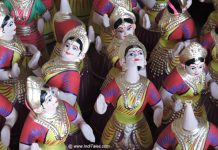Kuchipudi is a village in Andhra Pradesh that lends its name to one of the 7 classical dance forms from India. It was while reading a magazine a few years ago, I realized the name comes from a village in Krishna district in Andhra Pradesh. Since then, it was on my travel wishlist. I have seen many performances of this tradition during my stay in Hyderabad. I particularly remember watching a mesmerizing performance by Haleem Khan.

This time when I was invited by Andhra Pradesh to attend the Amaravati Global Music & Dance Festival, to me it was an opportunity to visit the historical village. On the final day of the festival, we set out to explore the village that is about 60 km from Vijayawada.
Sri Siddhendra Yogi Kuchipudi Kala Peetham

We landed at the gates of the Kala Peetham – the traditional dance institute affiliated with the Telugu University, Hyderabad. As we got down the car, we saw the statue of an elegant lady in black stone standing in the middle of the garden. There was a lotus in one hand and a fly-whisk in another. I could not get the iconography and was about to conclude that this is probably a depiction of Bharat Mata. I was soon corrected that this is the image of Telugu Talli or the mother of Telugu. India – you never cease to amaze me.

We moved inside and very appropriately a large Nataraja stood in Chola bronze. Along with it was a statue of Sh Siddhendra Yogi who is considered the father of modern-day Kuchipudi. Incidentally, the land for the institute was donated by the Quli Qutub Shah after he was enchanted by a traditional performance. The current building is relatively new with a proper hostel for the students. This building replaced an old building that lived for more than 100 years.
Siddhendra Yogi
After exchanging pleasantries with the institute staff and students, Anupama – an MPA student here walked us through the history of the village & dance form.
Bhama Kalapam

Anupama began by talking about a dance drama written by Siddhendra Yogi called Bhama-Kalapam. Bhama refers to Satyabhama – one of the eight wives of Lord Krishna. The story is about Satyabhama’s desire to merge with Krishna. However, she cannot, till she has greed, attachment, desire, and lust in her. She must give up that to reach Krishna. Metaphorically, it is the story of Jeevatma, or human life, and Paramatma, or the Divine. It is about the human desire to merge with God. And the obstacles that one must conquer to reach there.
Bhama Kalapam remains one of the most performed dance dramas in this form of dance/performance. We were told that so descriptive is the work that there is a night-long performance that describes only the braid of Satyabhama.
In fact, the whole of the Kuchipudi dance system is soaked in Vaishnavism or the following of Vishnu cult. Within Vishnu also, Krishna is a popular deity for those following the Bhakti movement. The district itself is called Krishna after the Krishna River flowing through it and merging with the sea here.
Yogi lived in the 17th CE when the Bhakti movement and Krishna devotion were at their peak.
History of Kuchipudi Village

Kuchipudi village was known by other names like Kuchelapuram or Kuchilapuri. Its ancient Sanskrit name was Kusilava-Puram meaning the village of the Kusilavas. A term used for traveling Bards & Dancers. The etymology of Kuchipudi itself talks about the ancient dance tradition of this place.
The current history of Kuchipudi can be traced from the medieval period onwards. However, we were told that archaeologists have recovered Buddhist images from this place in dancing poses. Not very usual for Buddhist images to be in dancing poses. But maybe such was the power of this land that even Buddhist monks could dance.

It is said that every family in the village has performers. Everyone knows this form of dance. They more often than not learn from their fathers. Yes, Kuchipudi followed a patriarchal lineage till very recently. All these families were Brahmin families. Anupama said in all there are only 13 families that form the village. And all of them pursue the dance form.
Traditionally, only male dancers performed this form of dance/performance. They would often dress as women and play those roles with an Elan. At the Sri Siddhendra Yogi Kuchipudi Kala Peetham, you can see lots of photographs of doyens of the performers in their female avatars.
Vedanta Lakshmi Narayana Sastri who lived in the early 20th CE was responsible for bringing many changes to the tradition. He introduced the dance form to women. Now you can see many women performing it. He took it outside the domain of the Brahmins and opened it up to anyone who wanted to learn.
Kuchipudi Dance
This dance form has 4 different parts to it:
- Vachika i.e. Speaking
- Aahaarya i.e. Costumes
- Aangika i.e. Body movements & Body postures
- Satvika i.e. Abhinay or expressions
Dancers both sing and speak to the audience. The whole of this dance form is a storytelling format. Where some parts are spoken, some enacted, some expressed only through facial expressions. The dance also involves a Sutradhar or a storyteller who at times is supported by a couple of more people. There is a lot more focus on Abhinaya or expressions in this form of dance/performance compared to other classical dance forms.
Dancers are accompanied by musicians who play instruments like Mridangam, Harmonium, and Violin. Two vocalists – a male and a female are a part of the ensemble.
Originally, Kuchipudi dance used to be a group performance with various actors playing different parts.
Costumes are an integral part of any dance drama. The performers of this form of dance, it seems used to wear ornaments made of light wood. In fact, most of the performing artists & their families used to carve their own ornaments. Just imagine how deeply they would be involved in their art to design the jewelry themselves. Now, of course, dancers wear metal jewelry sourced from traditional jewelers.
Watching Students Perform

The principal of the institute Sh Vedantam Ramalinga Sastry organized two performances for us by the students. The first performance had two boys performing live singing by the principal and his wife. The second performer performed on the Shiva Ashtakam. We were all lost in the swaying yet swift movements of the dancer. Since the students were performing at a very short notice they were in their daily wear. I missed the costumes. I could only imagine how beautiful would they look in the costumes and the right light.
It is sad to know that such creative places like this one are hardly known in India. While we should be proudly showcasing it to the world. How many places can boast to be a complete dancing village continuously for so long? I hope the students who have gained prominence in this performing art should talk about this village.
The students and the teachers of the institute were so simple and humble. They offered us simple South Indian food on the banana leaf. Believe me, this was the tastiest food I had in a long time.
Kuchipudi village

After the institute, we headed to the village temple that is dedicated to Bala Tripura Sundari – the gram Devi of the village. However, our first stop was a small temple dedicated to Siddhendra Yogi. It is a small temple where Veena sits on top.

Bala Tripura Sundari temple is a small temple in yellow with a gopuram of the same size as Shikhara of the temple. The temple is dedicated to Shiva and Parvati in the form of Bala Tripura Sundari. A Nataraja statue proudly sits on one side of the Shikhara. Temple pillars in pistachio green have small idols in various dance poses. All the dancers come and pray here before their performance to pray.

A new Cheruvu or lake called Natya Pushkarni is being developed next to the temple. It would have a statue of Siddhendra Yogi in the middle.
There are many other temples in the vicinity of the village. Hopefully, there would be a next time to explore it.
Travel Tips
- There are no hotels in the village. Vijayawada is the best place to stay, it offers all kinds of accommodation for visitors.
- The nearest airport and railhead are also at Vijayawada.
- We ate a simple vegetarian meal at the institute. They should be able to provide you with meals with prior notice.
- Walk around the village and feel it.
Recommend you read the following travel blog on places to visit in Andhra Pradesh.
Visakhapatnam’s popular RK Beach or Ramakrishna Beach
INS Kursura Submarine Museum at RK Beach














Hi!! Anuradha,
Your choice of places always amaze me. This is a very interesting place & well written article! Do they have any scheduled dance performances, if you visit the village?
Regds
Shweta
Thank you, Shweta. No, there are no performances as they hardly get any visitors. However, if you inform them, they will allow you to see the classes or let the students do an impromptu performance for you.
hi Anuradha
thank for the interesting articles. luv your blog
Thank you, Asha. Keep sharing your thoughts & feedback, they motivate me to travel more.
Namaste, Anuradha! You are lucky to get travel so much and we are very lucky to share it with you by pictures and information you give .I am always waiting for your next trip . God bless you ,
Thank you so much, Shobha for your blessings. Just returned from Nepal – visited Lumbini & Kapilvastu – will soon write about them. Do keep encouraging with your comments.
What a wonderful culture in India…Kuchipudi is a very beautiful art form. Even I want to learn this dance form.
It is Neha. Go & Learn.
A dance style from a village is so famous , wow ! You are really brilliant in this matter that you always choose something new to explore . Great info !!
Thank you so much, Yogi. I am just an explorer and share whatever I see. Have to admit I have been fortunate to visit such amazing places.
Beautiful article! Thank you for writing it:) It is a dream of mine to go and study dance in that village. Do you have information as to who to contact/how to get information about the dance school itself?
Glad you enjoyed the post on Kuchipudi. Just go there and get the information on dance courses, I am not sure about their web presence.
Kuchipudi, a pre-eminent Indian classical dance form counted among ten leading classical dance forms of India, is a dance-drama performance art that originated in a village of Krishna district of Andhra Pradesh, India. Similar to all leading Indian classical dance forms, Kuchipudi too evolved as a religious art rooting back to the age-old Hindu Sanskrit text ‘Natya Shastra’ and connects traditionally with temples, spiritual faiths and travelling bards.
A dance style from a village is so famous. Kuchipudi is one of the eight major Indian classical dances. People love to enjoy this.
Thank you for this brilliant content and enjoyable trip.
Do you have any floor plans pictures of the existing dance institute or any idea of how big the site of dance institute is?
Not really.